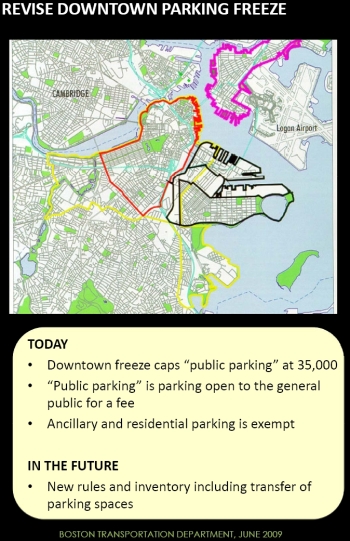 This is the fourth in a series of articles on the issues discussed at the June 22, 2009 public meeting for the Greenway District Planning Study with a focus on transportation.
This is the fourth in a series of articles on the issues discussed at the June 22, 2009 public meeting for the Greenway District Planning Study with a focus on transportation.
The City currently has a parking freeze at 35,000 public spaces set by the Boston Environment Department to moderate emissions within Boston. However, the BTD has indicated that it will review whether that number should be changed as part of its agenda for the future of Boston transportation. The actual number may actually be lower now because various garages and surface lots have closed or been modified as part of new developments.
Officials were vague regarding their intention to lower or raise the freeze number but it was implied that congestion and environmental concerns would imply a lower number. In answer to a resident question, the BTD’s Vineet Gupta indicated that parking needs for future commercial developments given incentives for public transportation and alternative commuting (bicycles, car sharing) would be lower now than in the past and that new parking should be more geared to residential needs.
The target maximum parking ratio has been set at 0.40 per occupant of office workers and residents. This is about where the current situation is today. Officials mentioned several times the negatives of having too many parking spaces (hmmm … I doubt they get too many complaints about that).
The BTD’s primary parking goal is to create balance between reducing congestion while supporting future development. A focus on reducing vehicle trips is important when allocating new parking spaces for different land uses. Distribution of spaces throughout the City can help minimize congestion so parking garages should be spread out. Initiatives such as bicycling, shared-use and electric car stations will figure as part of the review for the next decade of parking needs. Companies can also help the parking situation by providing subsidized transit passes and carpool spaces.
“Cruising” for parking spaces is a major problem and increases congestion. A North End resident raised the point that there are 4,000 resident stickers in the neighborhood but only 1,000 actual street spots. Officials are investigating web-based information on availability and pricing, but this is unlikely to have a significant impact on Boston’s street/garage situation. The BTD would like to shrink the differential between the cost for a metered space and that in a garage. Look for meters to go up in pricing and the hope is that incentives can be given to garages to bring their rates down.
The BRA appears to be involved in the parking freeze issue and speculation has risen that the BTD and BRA would eventually merge given the overlapping responsibilities. Both organizations are located in the same building at City Hall. Officials present at the meeting denied that any action was imminent.
More details can be found on the slide presentation from the GDPS meeting #4.



